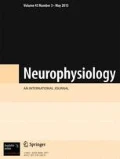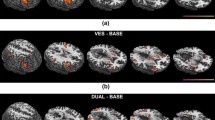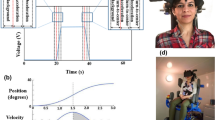In healthy subjects in the relaxed upward stance and perceiving a virtual visual environment (VVE), we recorded postural reactions to isolated visual and vestibular stimulations or their combinations. Lateral displacements of the visualized virtual scene were used as visual stimuli. The vestibular apparatus was stimulated by application of near-threshold galvanic current pulses to the proc. mastoidei of the temporal bones. Isolated VVE shifts evoked mild, nonetheless clear, body tilts readily distinguished in separate trials; at the same time, postural effects of isolated vestibular stimulation could be detected only after averaging of several trials synchronized with respect to the beginning of stimulation. Under conditions of simultaneous combined presentation of visual and vestibular stimuli, the direction of the resulting postural responses always corresponded to the direction of responses induced by VVE shifts. The contribution of an afferent volley from the vestibular organ depended on the coincidence/mismatch of the direction of motor response evoked by such a volley with the direction of response to visual stimulation. When both types of stimulations evoked unidirectional body tilts, postural responses were facilitated, and the resulting effect was greater than that of simple summation of the reactions to isolated actions of the above stimuli. In the case where isolated galvanic stimulation evoked a response opposite with respect to that induced by visual stimulation, the combined action of these stimuli of different modalities evoked postural responses identical in their magnitude, direction, and shape to those evoked by isolated visual stimulation. The above findings allow us to conclude that the effects of visual afferent input on the vertical posture under conditions of our experiments clearly dominate. In general, these results confirm the statement that neuronal structures involved in integrative processing of different afferent volleys preferably select certain type of afferentation carrying more significant or more detailed information on displacements (including oscillations) of the body in space.
Similar content being viewed by others
References
B. N. Smetanin, K. E. Popov, and V. Yu. Shlykov, “Changes in vestibular postural response determined by information content of visual feedback,” Neurophysiology, 22, No. 1, 66–72 (1990).
T. C. Britton, B. L. Day, P. Brown, et al., “Postural electromyographic responses in the arm and leg following galvanic vestibular stimulation in man,” Exp. Brain Res., 94, No. 1, 143–151 (1993).
M. S. Welgampola and J. G. Colebatch, “Vestibulospinal reflexes: quantitative effects of sensory feedback and postural task,” Exp. Brain Res., 139, 345–353 (2001).
R. C. Fitzpatrick, D. Burke, and S. C. Gandevia, “Task-dependent reflex responses and movement illusions evoked by galvanic vestibular stimulation in standing humans,” J. Physiol., 478, No. 2, 363–372 (1994).
B. L. Day and M. Guerraz, “Feedforward versus feedback modulation of human vestibular-evoked balance responses by visual self-motion information,” J. Physiol., 582, No. 1, 153–161 (2007).
B. N. Smetanin, K. E. Popov, V. S. Gurfinkel, and V. Yu. Shlykov, “Effect of movement and illusion of movement on human vestibulomotor response,” Neurophysiology, 20, No. 2, 192–196 (1988).
D. L. Wardman, J.L. Taylor, and R. C. Fitzpatrick, “Effects of galvanic vestibular stimulation on human posture and perception while standing,” J. Physiol., 551, No. 3, 1033–1042 (2003).
K. E. Popov, B. N. Smetanin, V. S. Gurfinkel, et al., “Spatial perception and vestibulomotor responses in man,” Neurophysiology, 18, No. 6, 779–787 (1986).
V. S. Gurfinkel’, K. E. Popov, B. N. Smetanin, and V. Yu. Shlykov, “Changes in the direction of vestibulomotor response in the course of adaptation to protracted static head turning in man,” Neurophysiology, 21, No. 2, 159–164 (1989).
M. Bove, C. Fenoggio, A. Tacchino, et al., “Interaction between vision and neck proprioception in the control of stance,” Neuroscience, 164, No. 4, 1601–1608 (2009).
B. N. Smetanin, G. V. Kozhina, and A. K. Popov, “Postural responses evoked by vibrational stimulation of the shin muscles under conditions of virtual visual environment”, Neurophysiology, 42, No. 1, 50–56 (2010).
A. Prochazka, “Sensorimotor gain control: a basic strategy of motor systems,” Prog. Neurobiol., 33, No. 4, 281–307 (1989).
B. L. Day and J. Cole, “Vestibular-evoked postural responses in the absence of somatosensory information,” Brain, 125, No. 9, 2081–2088 (2002).
M. Cenciarini and R. J. Peterka, “Stimulus-dependent changes in the vestibular contribution to human postural control,” J. Neurophysiol., 95, No. 5, 2733–2750 (2006).
S. V. Klimenko, I. N. Nikitin, and L. D. Nikitina, Avango. A System of Development of Virtual Environments, Protvino, Moscow (2006).
G. Burdea and P. Coiffet, Virtual Reality Technology, John Wiley and Sons, Inc., New York (1994).
Z. Ghanim, J. C. Lamy, A. Lackmy, et al., “Effects of galvanic mastoid stimulation in seated human subjects,” J. Appl. Physiol., 106, No. 3, 893–903 (2009).
J. J. Gibson, The Perception of the Visual World, Houghton-Mifflin, Boston (1950).
J. J. Gibson, “The visual perception of objective motion and subjective movement,” Psychol. Rev., 61, No. 6, 304–314 (1954).
J. J. Gibson, “Visually controlled locomotion and visual orientation in animals,” Br. J. Psychol., 49, No. 3, 182–194 (1958).
M. S. Banks, S. M. Ehrlich, B. T. Backus, and J. A. Crowell, “Estimating heading during real and simulated eye movements,” Vision Res., 36, No. 2, 431–443 (1996).
J. A. Crowell, M. S. Banks, K. V. Shenoy, and R. A. Andersen, “Visual self-motion perception during head turns,” Nat. Neurosci., 1, No. 8, 732–737 (1998).
P. A. Warren and S. K. Rushton, “Optic flow processing for the assessment of object movement during ego movement,” Curr. Biol., 19, No. 18, 1555–1560 (2009).
K. H. Britten, “Mechanisms of self-motion perception,” Annu. Rev. Neurosci., 31, 389–410 (2008).
F. E. Guedry, “Psychophysics of vestibular sensation,” in: Handbook of Sensory Physiology. The Vestibular System, H. H. Kornhuber (ed.), Springer-Verlag, New York (1974), pp. 1–154.
A. J. Benson, M. B. Spencer, and J. R. Stott, “Thresholds for the detection of the direction of whole-body linear movement in the horizontal plane,” Aviat. Space Environ. Med., 57, No. 11, 1088–1096 (1986).
Author information
Authors and Affiliations
Corresponding author
Additional information
Neirofiziologiya/Neurophysiology, Vol. 43, No. 5, pp. 435–442, September–October, 2011.
Rights and permissions
About this article
Cite this article
Smetanin, B.N., Kozhina, G.V. & Popov, A.K. Effects of Near-Threshold Stimulation of the Vestibular Apparatus on Postural Responses Evoked by Displacements of the Visualized Surrounding. Neurophysiology 43, 377–383 (2012). https://doi.org/10.1007/s11062-012-9237-5
Received:
Published:
Issue Date:
DOI: https://doi.org/10.1007/s11062-012-9237-5




